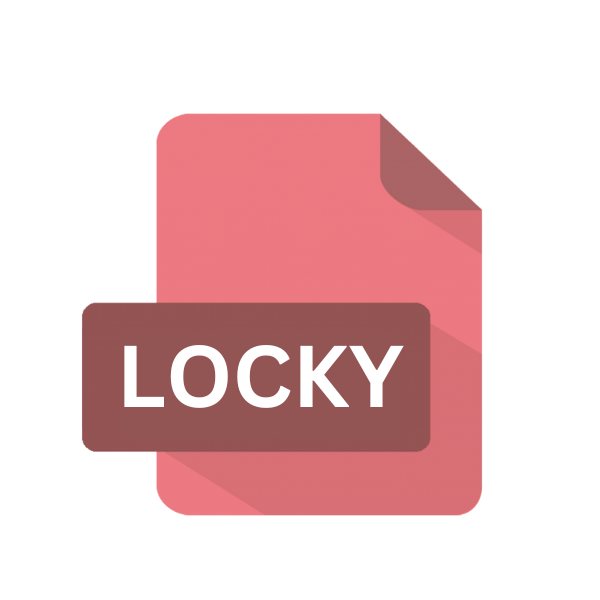.LOCKY File Extension

Locky Ransomware Encrypted File
| Developer | N/A |
| Popularity | |
| Category | Encoded Files |
| Format | .LOCKY |
| Cross Platform | Update Soon |
What is an LOCKY file?
The .LOCKY file extension is synonymous with the notorious Locky ransomware. This file extension represents files that have been encrypted by the Locky ransomware, rendering them inaccessible to the rightful owners.
Understanding the origin, history, structure, and implications of this file extension is crucial for combating the menace of ransomware attacks.
More Information.
Locky ransomware gained infamy for its widespread distribution through malicious email attachments, particularly in the form of .doc and .xls files containing malicious macros.
Once executed, Locky would encrypt a wide range of file types on the victim’s system, appending the .LOCKY extension to each encrypted file. The ransomware then displayed a ransom note demanding payment in Bitcoin for the decryption key.
Origin Of This File.
The .LOCKY file extension emerged alongside the Locky ransomware, which made its first appearance in early 2016. Developed by cybercriminals, Locky was designed to encrypt files on a victim’s computer and demand a ransom payment in exchange for the decryption key.
The file extension “.LOCKY” is appended to the encrypted files as a marker of their compromised state.
File Structure Technical Specification.
The .LOCKY file extension signifies that the associated file has undergone encryption by the Locky ransomware using strong cryptographic algorithms, typically RSA and AES.
This renders the files inaccessible without the corresponding decryption key. The file structure remains intact, but the contents are scrambled beyond recognition.
How to Convert the File?
Converting .LOCKY encrypted files back to their original format without the decryption key is virtually impossible due to the strong encryption algorithms employed by Locky ransomware. Victims have several options:
- Payment: Some victims may choose to pay the ransom in the hope of receiving the decryption key. However, this approach is risky, as there is no guarantee that the attackers will honor their end of the bargain.
- Data Recovery: Victims can attempt to restore encrypted files from backups or use data recovery tools to recover lost data. However, this method is only effective if reliable backups are available and if the ransomware has not deleted or encrypted backup files.
- Security Tools: Specialized security tools and decryption utilities may occasionally become available to decrypt files encrypted by certain ransomware variants. Victims should research available options and consult with cybersecurity experts before attempting file recovery.
Advantages And Disadvantages.
Advantage:
- Effective Extortion: The .LOCKY file extension enables cybercriminals to effectively extort ransom payments from victims by encrypting valuable files, thereby maximizing financial gain.
- Stealthy Operation: Locky ransomware operates stealthily, often evading detection by traditional antivirus solutions, allowing attackers to carry out their malicious activities undetected for extended periods.
- Minimal Effort, Maximum Impact: With relatively minimal effort, attackers can deploy Locky ransomware on a large scale, encrypting files en masse and demanding ransom payments for decryption keys, resulting in significant financial returns.
Disadvantage:
- Financial Loss: Victims of Locky ransomware face substantial financial losses due to ransom payments, as well as potential costs associated with data recovery, system restoration, and cybersecurity measures.
- Data Breach Risks: The encryption of sensitive files by Locky ransomware poses significant data breach risks, potentially exposing confidential information to unauthorized access and exploitation by cybercriminals.
- Operational Disruption: Locky ransomware can disrupt normal business operations by encrypting critical files, leading to productivity losses, downtime, and reputational damage for affected individuals and organizations.
How to Open LOCKY?
Open In Windows
- Ensure that the file has been decrypted using a decryption tool or by obtaining the decryption key.
- Once decrypted, simply double-click on the file, and it should open with the appropriate application, such as Microsoft Word, Excel, or any other compatible software installed on your Windows system.
Open In Linux
- Decrypt the .LOCKY encrypted file using available decryption tools or methods.
- After decryption, use compatible applications like LibreOffice or WPS Office to open the decrypted file on your Linux system.
Open In MAC
- Decrypt the .LOCKY encrypted file using decryption tools or methods compatible with macOS.
- Once decrypted, you can open the file using native macOS applications like Pages, Numbers, or Keynote, depending on the file type.
Open In Android
- Decrypt the .LOCKY encrypted file using appropriate decryption tools or methods compatible with Android devices.
- After decryption, you can access the decrypted file using compatible apps available on the Google Play Store, such as Microsoft Office or Google Docs.
Open In IOS
- Decrypt the .LOCKY encrypted file using decryption tools or methods compatible with iOS devices.
- Once decrypted, you can open the file using native iOS productivity apps like Pages, Numbers, or Keynote, depending on the file type.
Open in Others
- Depending on the file type, decrypted files can be opened using a wide range of third-party applications available for different platforms. Ensure that the file has been decrypted before attempting to open it with any application.
- Explore various file viewer or editor applications compatible with your specific file type and operating system to open the decrypted .LOCKY file.













